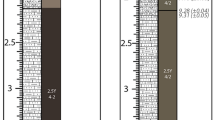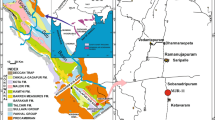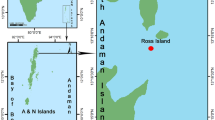Abstract
The objective of the present article is to document the first stratigraphic occurrence of the colonial oculinid Madrepora, known from the modern seas as an azooxanthellate taxon that contributes to the formation of deep-water coral reefs. The Upper Cretaceous specimens of Madrepora sp. reported herein from Poland were recovered from Upper Maastrichtian (Nasiłów and Bochotnica localities) and Lower Maastrichtian (Bliżów locality) siliceous limestones. The corals are preserved as imprints of the branch fragments and molds of the calices. Despite their moldic preservation, the coral remains exhibit key generic features of the genus Madrepora; including (1) sympodial colony growth form with calices arranged in opposite and alternating rows in one plane of the branch, and (2) imprints of the granular coenosteum texture, occasionally showing peculiar reticulate patterns. Some features of the Cretaceous Madrepora sp., such as the reticulate coenosteum texture, the range of the corallite diameter (2.8–4 mm), and the arrangement of the septa in three regular cycles resemble the skeletal features of the modern, typically constructional, species M. oculata (type species). The lack of any evidence of coral buildups and related debris in the whole Upper Cretaceous/Paleogene sequences from Poland and the sparse occurrence of colony fragments, suggests that the Cretaceous Madrepora sp. formed small, isolated colonies.





Similar content being viewed by others
References
Abdel-Gawad GI (1986) Maastrichtian non-cephalopod mollusks (Scaphopoda, Gastropoda and Bivalvia) of the Middle Vistula Valley, Central Poland. Acta Geologica Polonica 36:69–224
Alcock A (1902) Diagnoses and descriptions of new species of corals from the Siboga expedition. Tijdschrift der Nederlandsche Dierkundige Vereeniging 7:89–115
Alloiteau J (1952) Madréporaires Post-Paléozoiques. In: Pivetau J (ed), Traité de Paléontologie 1:539–684
Alloiteau J (1958) Monographie des madréporaires fossiles de Madagascar. Annales Géologiques de Madagascar 25:1–218
Baron-Szabo RC (2002) Scleractinian corals of the Cretaceous. RC Baron-Szabo, privately published, Knoxville, Tennessee, 539 pp
Bernecker M, Weidlich O (1990) The Danian (Paleocene) coral limestone of Fakse, Denmark: a model for ancient aphotic, azooxanthellate coral mounds. Facies 22:103–138
Bernecker M, Weidlich O (2005) Azooxanthellate corals in the Late Maastrichtian–Early Paleocene of the Danish basin: bryozoan- and coral mounds in a boreal shelf setting. In: Freiwald A, Roberts JM (eds) Cold-water corals and ecosystems. Springer, Berlin, Heidelberg, New York, pp 3–25
Birkelund T (1957) Upper Cretaceous belemnites from Denmark. Biologiske Skrifter, Kongelige Danske Videnskabernes Selskab 9:1–69
Błaszkiewicz A (1980) Campanian and Maastrichtian ammonites of the Middle Vistula River Valley, Poland: a stratigraphic-paleontological study. Prace Instytutu Geologicznego 92:3–63
Cairns SD (1979) The deep-water Scleractinia of the Caribbean Sea and adjacent waters. Studies on the fauna of Curaçao and other Caribbean Islands 180:1–341
Cairns SD (1991) A revision of the ahermatypic Scleractinia of the Galápagos and Cocos Islands. Smithsonian Contrib Zool 504:1–32
Cairns SD (1998) Azooxanthellate Scleractinia (Cnidaria: Anthozoa) of Western Australia. Records of the Western Australian Museum 18:361–417
Cairns SD (1999) Cnidaria Anthozoa: deep-water azooxanthellate Scleractinia from Vanuatu, and Wallis and Futuna Islands. In: Crosnier A (ed) Résultats des Campagnes MUSORSTOM, vol 20. Mémoires du Muséum national d’Histoire naturelle 180;31–167
Cairns SD (2001) A generic revision and phylogenetic analysis of the Dendrophylliidae (Cnidaria: Scleractinia). Smithsonian Contrib Zool 615:1–88
Cairns SD, Hoeksema BW, Van Der Land J (1999) Appendix: list of stony coral. In: Cairns SD (ed) Species richness of Recent Scleratinia C. Atoll Res Bull 459:13–16
Cairns SD, Stanley GD (1981) Ahermatypic coral banks: living and fossil counterparts. Proc Fourth International Coral Reef Symposium, Manila 1:611–618
Cairns SD, Zibrowius H (1997) Cnidaria Anthozoa: Azooxanthellate Scleractinia from the Philippine and Indonesian Regions. In: Crosnier A, Bouchet P (eds) Resultats des Campagnes MUSORSTOM, vol 16. Mémoires du muséum d’histoire naturelle 172:27–243
Cieśliński S, Rzechowski J (1993) Mapa geologiczna podłoża czwartorzędu Roztocza między Tomaszowem Lubelskim a Hrebennem. In: Harasimiuk M, Krawczuk J, Rzechowski J (eds) Tektonika Roztocza i jej aspekty sedymentologiczne, hydrologiczne i geomorfologiczno-krajobrazowe. Towarzystwo Wolnej Wszechnicy Polskiej, Lublin, pp 38–46
Cieśliński S, Wyrwicka K (1970) Kreda obszaru lubelskiego. In: Przewodnik XLII Zjazdu Polskiego Towarzystwa Geologicznego, Lublin 3–5 września 1970, Wydawnictwa Geologiczne, Warszawa, pp 56–74
Cuif JP, Lecointre G, Perrin C, Tillier A, Tillier S (2003) Patterns of septal biomineralization in Scleractinia compared with their 28S rRNA phylogeny: a dual approach for a new taxonomic framework. Zool Scripta 32:459–473
De Angelis d’Ossat G, Neviani A (1897) Corallari e briozoi neogenici di Sardegna. Bolletino dell Società Geologica Italiana 15(1896):571–598
Duncan PM (1873) A description of the Madreporaria dredged up during the expedition of H.M.S. “Porcupine” in 1869 and 1870. Trans Zool Soc Lond 8:303–344
Felix J (1909) Über die fossilen Korallen der Snow Hill-Insel und der Seymour-Insel. Wissenschaftliche Ergebnisse der Schwedischen Südpolar-Expedition 1901–1903 3:1–15
Filkorn HF (1993) Deep- or cold-water coral bioherms in the fossil record. Paleobios (Supplement, Cal Paleo 1993 Abstracts) 14:5–6
Filkorn HF (1994) Fossil scleractinian corals from James Ross Basin, Antarctica. Antarct Res Series 65:1–84
Floris S (1980) The coral banks of the Danian of Denmark. Acta Palaeontol Polon 25:531–540
Freiwald A (1998) Geobiology of Lophelia pertusa (Scleractinia) reefs in the north Atlantic. Habilitation thesis, Univ Bremen, 116 pp
Freiwald A (2002) Reef-forming cold-water corals. In: Wefer G, Billett D, Hebbeln D, Jørgensen BB, Schlüter M, van Weering TCE (eds) Ocean margin systems. Springer, Berlin Heidelberg New York, pp 365–385
Freiwald A, Fosså JH, Grehan A, Koslow T, Roberts JM (2004) Cold-water coral reefs. UNEP-WCMC, Cambridge, UK, 84 pp
Fukami H, Budd AF, Paulay G, Sole-Cava A, Chen CA, Iwao K, Knowlton N (2004) Conventional taxonomy obscures deep divergence between Pacific and Atlantic corals. Nature 427:832–835
Gautret P, Cuif JP, Stolarski J (2000) Organic components of the skeleton of scleractinian corals–evidence from in situ acridine orange staining. Acta Palaeontol Polon 45:107–118
Hakenberg M, Świdrowska J (2001) Cretaceous basin evolution in the Lublin area along the Teisseyre-Tornquist Zone (SE Poland). Ann Soc Geol Polon 71:1–20
Jeletzky JA (1951) Die Stratigraphie und Belemnitenfauna des Obercampan und Maastricht Westfalens, Nordwestdeutschlands und Dänemarks, sowie einige allgemeine Gliederungs-Probleme der jüngeren borealen Oberkreide Eurasiens. Beihefte zum Geol Jahrb 1:1–142
Kaandorp JA, Kübler JE (2001) The algorithmic beauty of seaweeds, sponges and corals. Springer, Berlin Heidelberg New York, 194 pp
Kerr AM (2005) Molecular and morphological supertree of stony corals (Anthozoa: Scleractinia) using matrix representation parsimony. Biol Rev 80:1–16
Krassowska A (1997) Upper Cretaceous (Upper Albian-Cenomanian). In: The epicontinental Permian and Mesozoic in Poland [in Polish with English summary]. Prace Państwowego Instytutu Geologicznego 153:367–402
Lauxmann U (1991) Revision der oberjurassichen Korallen von Württemberg (SW-Deutschland), exclusive Fungiina. Palaeontolographica A 219:107–175
Le Goff-Vitry MC, Rogers AD, Baglow D (2004) A deep-sea slant on the molecular phylogeny of the Scleractinia. Molec Phylogenet Evol 30:167–177
Lesueur CA (1821) Déscription de plusieurs animaux appartenant aux polypiers lamellifères de M. le Chev. de Lamarck. Mémoires du Muséum d’Histoire naturelle 6:271–298
Linnaeus C (1758) Systema Naturae per regnia tria naturae, secundum Classes, Ordines, Genera, Species. Tomus I. Regnum Animale. Holmiae, Editio Decima, Reformata, 824 pp
Lonsdale W (1850) Description of the fossils of the Chalk Formation. Notes on the corals. In: Dixon F (ed) The geology and fossils of the Tertiary and Cretaceous formation of Sussex, Longman, Brown, Green, and Longmans, London, pp 237–324
Machalski M (1998) The Cretaceous-Tertiary boundary in Central Poland. Przegląd Geologiczny 46:1153–1161
Machalski M (2005) Late Maastrichtian and earliest Danian scaphitid ammonites from central Europe: taxonomy, evolution, and extinction. Acta Palaeontol Polon 50:653–696
Machalski M, Walaszczyk I (1987) Faunal condensation and mixing in the uppermost Maastrichtian/Danian Greensand (Middle Vistula Valley, Central Poland). Acta Geol Polon 37:75–91
Malicki A, Karczmarz K, Popiel JS (1967) Materials for the Upper Cretaceous floras of the Lublin Upland and Roztocze [in Polish with English summary]. Ann Universitatis Mariae Curie-Skłodowska 22:219–236
Medina M, Collins, AG, Takaoka TL, Kuehl JV, Boore JL (2006) Naked corals: skeleton loss in Scleractinia. Proc Nat Acad Sci USA 103:9096–9100
Milne-Edwards H, Haime J (1849) Mémoire sur les polypiers appartenant à la famille des Oculinides, au groupe intermédiaire des Pseudastréides et à la famille des Fongides (extrait). Acad Sci Paris CR 29:67–73
Milne-Edwards H, Haime J (1857) Histoire naturelle des Coralliaires ou polypes proprement dits. Tome second: classification et description des Zoanthaires sclérodermés de la section des Madréporaires apores. Paris: Roret, 633 pp
Moseley HN (1881) Report on certain Hydroid, Alcyonarian, and Madreporarian corals procured during the voyage of H.M.S. Challenger, in the years 1873–1876. Zoology 2:1–248
Niebuhr B (2003) Late Campanian and Early Maastrichtian ammonites from the white chalk of Kronsmoor (northern Germany) – taxonomy and stratigraphy. Acta Geol Polon 53:257–281
Nielsen BK (1922) Zoantharia from Senone and Paleocene Deposits in Denmark and Skaane. Det Kongelige Danske Videnskabernes Selskabs Skrifter, Naturvidenskabelige og Mathematiske Afhandlinger 3:202–233
Odin GS, Lamaurelle MA (2001) The global Campanian–Maastrichtian stage boundary at Tercis les Bains, Landes, SW France. Episodes 4:229–238
de Pourtalès LF (1867) Contributions to the fauna of the Gulf Stream at great depths. Bull Mus Comp Zool 1:103–120
de Pourtalès LF (1871) Deep-sea corals. Illus Cata Mus Comp Zool 4:1–93
Pożaryski W (1956) Kreda. In: Książkiewicz M, Dżułyński S (eds) Regionalna Geologia Polski, Tom II. Region Lubelski, Kraków, pp 14–56
Quenstedt FA (1858) Der Jura. Laupp, Tübingen, 842 pp
Radwański A (1996) The predation upon, and the extinction of, the latest Maastrichtian populations of the ammonite species Hoploscaphites constrictus (J. Sowerby, 1817) from the Middle Vistula Valley, Central Poland. Acta Geol Polon 46:117–135
Roberts JM, Wheeler AJ, Freiwald A (2006) Reefs of the deep: the biology and geology of cold-water coral ecosystems. Science 312:543–547
Romano SL, Palumbi SR (1996) Evolution of scleractinian corals inferred from molecular systematics. Science 271:640–642
Romano SL, Cairns SD (2000) Molecular phylogenetic hypotheses for the evolution of scleractinian corals. Bull Mar Sci 67:1043–1068
Seguenza G (1864) Disquisizioni paleontologiche intorno ai Corallarii fossili delle rocce terziarie del distretto di Messina. Memorie della Reale Accademia delle Scienze di Torino (ser 2) 21:399–560
Siemiradzki J (1926) Sur les coraliaires de crétacé supérieur de Pologne. Kosmos 51:313–326
Świdrowska J, Hakenberg M (1999) Subsidence and the problem of incipient inversion in the Mid-Polish Trough based on thickness maps and Cretaceous lithofacies analysis. Przegląd Geologiczny 47:61–68
Stolarski J (1996) Paleogene corals from Seymour Island, Antarctic Peninsula. Palaeontol Polon 55:51–63
Squires DF (1958) The Cretaceous and Tertiary corals of New Zealand. NZ Geol Surv Paleontol Bull 29:1–106
Tenison-Woods JE (1880) Corals and Bryozoa of the Neozoic period in New Zealand. Colonial Museum and Geological Survey Department, Palaeontology of New Zealand 4:1–34
Vaughan TW (1900) The Eocene and Lower Oligocene coral faunas of the United States, with descriptions of a few doubtfully Cretaceous species. US Geol Surv Monogr 39:1–263
Vaughan TW (1907) Recent Madreporaria of the Hawaiian Islands and Laysan. Bull US Nat Museum 59:1–427
Vaughan TW (1919) Fossil corals from Central America, Cuba, and Porto Rico, with an account of the American Tertiary, Pleistocene, and recent coral reefs. Bull US Nat Museum 103:189–524
Vaughan TW, Wells JW (1943) Revision of the suborders, families, and genera of the Scleractinia. Geol Soc Am Spec Paper 44:1–363
Verrill AE (1901) Variations and nomenclature of Bermudian, West Indian and Brazilian reef corals, with notes on various Indo-Pacific corals. Trans Connecticut Academy of Arts and Sciences 11:63–168
Vertino A (2003) Sclerattiniari Plio-Pleistocenici ed attuali del Mediterraneo (Sistematica, Biostratinomia e Paleoecologia). PhD Thesis, University of Messina, 306 pp
Walaszczyk I, Cobban WA, Odin GS (2002) The inoceramid succession across the Campanian–Maastrichtian boundary. Bull Geol Soc Denmark 49:53–60
Walaszczyk I (2004) Inoceramids and inoceramid biostratigraphy of the Upper Campanian to basal Maastrichtian of the Middle Vistula Valley, central Poland. Acta Geol Polon 54:95–168
Wells JW (1956) Scleractinia. In: Moore RC (ed) Treatise on invertebrate paleontology, part F (Coelenterata). The University of Kansas Press, Lawrence, Kansas, F328–F444
Wells JW (1977) Eocene corals from Eua, Tonga. US Geol Surv Washington, DC, Prof Paper 640–G:1–9
Wilson JB (1979) “Patch” development of the deep-water coral Lophelia pertusa (L.) on Rockall Bank. J Mar Biol Assoc UK 59:165–177
Yabe H, Eguchi M (1943) Note on the two Hexacoralla, Goniocorella dumosa (Alcock) and Bantamia gerthi gen et sp. Nov. Proc Imperial Acad Jpn 19:494–500
Zibrowius H (1980) Les scléractiniaires de la Méditerranée et de l’Atlantique nord oriental. Mémoires de l’Institut Océanographique, Monaco 11:1–284
Zibrowius H (1989) Mise au point sur les Scléractiniaires comme indicateurs de profondeur (Cnidaria: Anthozoa). Géologie Méditerranéenne 15:27–47
Acknowledgements
We are thankful to Krzysztof Dembicz (Faculty of Geology, Warsaw University) and Marcin Machalski (Institute of Paleobiology, Warsaw) for making available coral material from Nasiłów and Bliżów quarries, respectively, and for discussion during preparation of the manuscript. Ewa Roniewicz (Institute of Paleobiology, Warsaw) and André Freiwald (Institut für Paläontologie, Universität Erlangen) and Antonietta Rosso (Geology Department, Catania) provided useful comments on the manuscript. Michaela Bernecker (Institut für Paläontologie, Universität Erlangen) and Marco Taviani (Istituto di Scienze Marine, CNR Bologna) reviewed the manuscript and provided many helpful suggestions for its improvement. This research has been financially supported by the Institute of Paleobiology, Polish Academy of Sciences and the EURODOM (European Deep Ocean Margins) project HPRN-CT-2002-00212, to JS and AV, respectively.
Author information
Authors and Affiliations
Corresponding author
Rights and permissions
About this article
Cite this article
Stolarski, J., Vertino, A. First Mesozoic record of the scleractinian Madrepora from the Maastrichtian siliceous limestones of Poland. Facies 53, 67–78 (2007). https://doi.org/10.1007/s10347-006-0089-6
Received:
Accepted:
Published:
Issue Date:
DOI: https://doi.org/10.1007/s10347-006-0089-6




